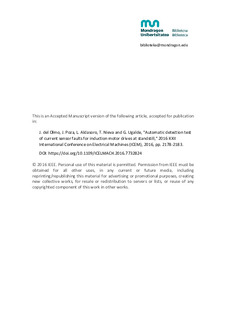Title
Automatic detection test of current sensor faults for induction motor drives at standstillxmlui.dri2xhtml.METS-1.0.item-contributorOtherinstitution
https://ror.org/02afbgp72Version
http://purl.org/coar/version/c_ab4af688f83e57aa
Rights
© 2016 IEEEAccess
http://purl.org/coar/access_right/c_abf2Publisher’s version
https://doi.org/10.1109/ICELMACH.2016.7732824Published at
Proceedings of the XXII International Conference on Electrical Machines (ICEM) Lausanne, Switzerland. Pp. 2178-2183. IEEE, 2016Publisher
IEEEKeywords
Stators
induction motor
Current measurement
Transient analysis ... [+]
induction motor
Current measurement
Transient analysis ... [+]
Stators
induction motor
Current measurement
Transient analysis
Inductance
Observers [-]
induction motor
Current measurement
Transient analysis
Inductance
Observers [-]
Abstract
This paper proposes an automatic detection test of gain faults in current sensors. An offline test is applied when the machine is not operating. The designed test operates at standstill without being ... [+]
This paper proposes an automatic detection test of gain faults in current sensors. An offline test is applied when the machine is not operating. The designed test operates at standstill without being necessary to disconnect the machine from the application. Current sensors are part of a commercial induction motor drive composed by a bilevel inverter, an induction motor and an electronic control unit. Therefore, in the selection of the approach, memory usage, computational cost and real-time implementation have been carefully considered. The algorithm, based on the model of the motor, uses the parameter aLs of the machine as a fault indicator. In order to estimate that parameter, firstly, precalculated width voltage pulses are injected into the motor using the inverter. Secondly the generated current slope is measured. Finally the estimation is compared to its nominal value. Once the theoretical basis is explained, the execution sequence of the test and the simulation results are presented. In addition, some enhancements are proposed to improve the resolution and accuracy of the approach, because the real conditions of the test do not follow exactly some of the theoretical assumptions. [-]






















